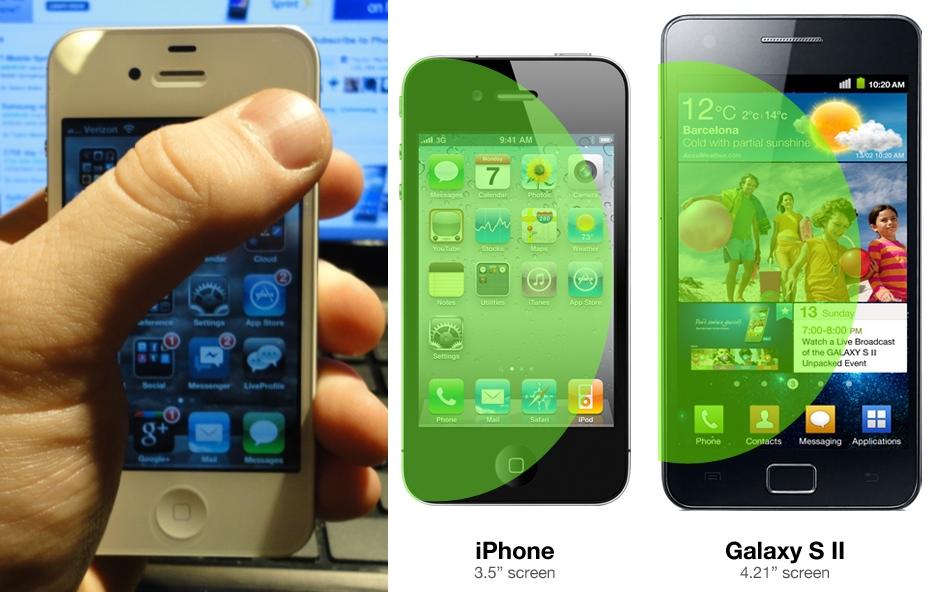
After 16 months of escalating rumors and speculation, Apple officially announced the iPhone 4S a week ago to quite a bit of disappointment. The disappointment isn't because the 4S is a bad device. It's a decent upgrade over the previous model, but people were expecting and hoping for a redesign. And most of those hopes weren't necessarily for a totally new design, they were for a larger display.
Since Android OEMs entered the scene, mobile displays have undergone a major transformation. Makers like HTC, Samsung, LG and Motorola have adopted the 4.3-inch display size as a standard, and some have released even larger devices. Dell was the first to make a "phone" that broke the 5-inch barrier with the Streak, followed by Samsung with the Galaxy Note at 5.3-inches.
The original iPhone launched back in the summer of 2007 with a 3.5-inch display. Aside from changing display type and resolution, little has changed. The display is still a mere 3.5-inches, which is perfectly fine for many. But the consensus seems to be that 3.5-inches it too small, particularly for those with big hands.

After the keynote last week, we were left wondering just why Apple decided not to go with a larger display, even if they kept the same design. Gizmodo dug up a possible explanation by one named Dustin Curtis, who has a pretty good idea as to why Apple kept the 3.5-incher. On his personal blog, he says while using a Galaxy S II and holding the phone with his left hand, he can't reach the other side of the display. He goes on to explain:
"Touching the upper right corner of the screen on the Galaxy S II using one hand, with its 4.27-inch screen, while you’re walking down the street looking at Google Maps, is extremely difficult and frustrating. I pulled out my iPhone 4 to do a quick test, and it turns out that when you hold the iPhone in your left hand and articulate your thumb, you can reach almost exactly to the other side of the screen."
Curtis' explanation makes sense, but there's one flaw: it's based off of his hands alone. The graphic he used (shown above) likely does not account for people with bigger – or even smaller – hands. When doing the same test with my iPhone, I can reach all the way to the top corner of the display without even stretching my thumb. But my hand nearly swallows the iPhone whole to begin with. This might make it easy to reach any corner of the display while using one hand, but it also makes typing and a few other tasks a chore. I didn't have a Galaxy S II laying around, but I did the same thing with a HD7 (4.3-inch display, ever so slightly larger than the Galaxy S II). It took some stretching to reach the top right corner with my left thumb, but this is something I've grown used to while using larger phones. I would rather have to stretch and readjust my grip to touch corners than to be cramped on a tiny display.
So why didn't Apple conform to the more luxurious, larger displays like their Android and Windows Phone counterparts? My guess is they were trying to streamline the manufacturing process, keep costs down and to postpone the issue of changing resolution once again. Apple Insider reported that Chris Whitmore of Deutsche Bank believes Apple will attain manufacturing margins of 70 percent and beyond (as opposed to roughly 38 percent for the iPod Touch).
You may recall that Apple has ran into a slew of manufacturing problems during the last two years, and they have had trouble keeping up with high demand with both iPhone and iPad models. Keeping the design virtually the same, they can use many of the same materials from the iPhone 4, minimize changes to the manufacturing process and keep costs substantially down while yielding a higher subsidy on average than other manufacturers. Despite people being disappointed, people are still flocking to the 4S – if you think Apple didn't know this would happen, you're in denial.
Obviously, I have my gripes with the small display on the iPhone, but I've grown used to it with time. It's beautiful, bright and I love the design of the phone. But in my use, 4-inch and larger displays offer a more pleasing experience, especially when viewing media, typing or browsing the Web. I tend to err on the side of too much display over not enough.
The 3.5-inch display will suffice for now, but if Apple doesn't deliver a larger display in the iPhone 5, they may face some real adversity for once. Not everyone wants a larger display, but there are obviously some people out there who need more than 3.5-inches to be comfortable with a handset.
What say you, pups? What is the perfect display size for you? Is the 3.5-inch touchscreen on the iPhone too small, or do you find it to be the perfect fit? Chime in below!